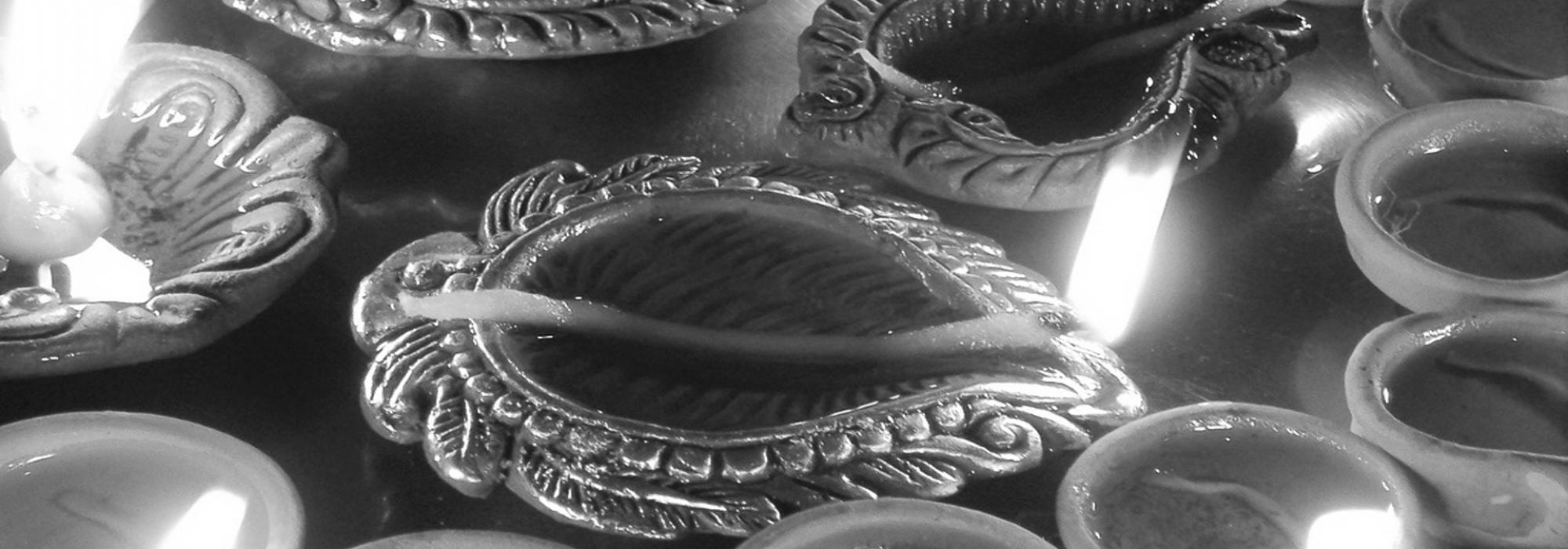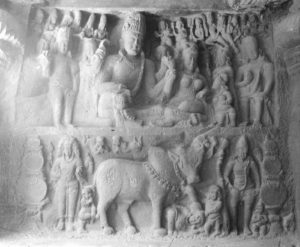A popular prayer from the Upanishads implores a movement from lies to truth, from darkness to brightness, and from death to eternal life (Brihadaranyaka Upanishad 1.3.28). The second line of this prayer – तमसो मा ज्योतिर्गमय – is no doubt a metaphor, the darkness representing ignorance and brightness representing wisdom. Ignorance often results from laziness, and the word ‘tamas’ in Sanskrit captures all these shades of meaning – darkness, lethargy, ignorance, error, illusion, etc. Deepavali, in some sense, is victory over tamas. When celebrated with thoughtful happiness, it pleases the paranjyoti (supreme light), which is the source lamp of all knowledge and arts. It is the light of wisdom and has been described as 'सत्तामात्रं निर्विशेषं निरीहं स त्वं साक्षाद् विष्णुरध्यात्मदीप:' (Bhagavata Purana).
The word ‘deepavali’ is a combination of two words, दीप and आवलि, where दीप means ‘lamp’ and आवलि means ‘row’. Rows of lamps are lit, not merely in homes and temples, but also in ashramas, town squares, banks of rivers, and seashores. All Indians celebrate Deepavali irrespective of social or economic background. It is also celebrated in several countries outside of India.
We celebrate Deepavali in the month of Ashvayuja (or Ashvina) at the end of the krishna-paksha (the fortnight of the waning moon, ending with amavasya). In Tamil Nadu it is celebrated on Naraka Chaturdashi (which usually falls in the month of Aippasi) as also in Kerala. In the Andhra country, the celebrations are extended to the day of the new moon. In Karnataka, Naraka Chaturdashi and Balipadyami (the first day of the shukla-paksha) are the days of celebration. Often, Deepavali festivities carry on for four or five days.
The First Day
Day 1 is typically Naraka Chaturdashi, a day that is remembered for the slaying of Narakasura by Krishna. In some parts of India, festivities begin a day or two earlier. In Maharashtra for instance, Deepavali starts on the twelfth day with Vasubaras, worshipping cows and bulls. In many parts of Northern and Western India, Deepavali starts on the thirteenth day with Dhanteras (Dhana Trayodashi).
The Second Day
Day 2 – the last day of the Ashvina month – is the day of the new moon, amavasya. It is celebrated with a Mahalakshmi puja, worshiping the goddess of wealth and prosperity. Many traders and merchants begin their year on this day and open fresh books of accounts.
The Third Day
Day 3 – the first day of the Kartika month – is known variously as Kartika Shuddha Pratipat, Bali Pratipat, Bali Padyami, Balindra Vijaya, and Dyuta Pratipat. This is the day Bali Chakravarti was silenced by Vamana, an avatara of Vishnu. The Puranas tell us to worship the emperor Bali with the verse:
बलिराज नमस्तुभ्यं विरोचनसुत प्रभो ।
भविष्येन्द्र सुराराते विष्णुसान्निध्यदो भव ॥
O King Bali, son of Virochana, I bow to you, O Lord
You’re going to become an Indra in future; bless us to get close to Vishnu!
This is a beautiful example where the asuras or daityas (loosely translated as ‘demons’) are not demonized. In the tradition of sanatana dharma, since there is no concept of ‘eternal evil,’ there is always a redemption or release for even the evil ones, whether it is Ravana or Mahishasura. In the works of the itihasas and puranas, often an errant one is reborn as a villain in the next birth, only to be killed by the Supreme and then attain release. Hinduism recognized early on that the real enemies were not in the form of humans or animals, but in the form of lust, anger, greed, infatuation, arrogance, and jealousy (the ari-shad-varga or the six fundamental enemies).
Bali Pratipat is also the day of worshiping cows and bulls, an act of expressing our gratitude to the mute animals who serve us diligently all year long. It is noteworthy that the deepaarati is performed not only to deities but to humans, animals, and plants:
नीराजयेयुर्देवांस्तु विप्रान् गाश्च तुरङ्गमान् ।
ज्येष्ठान्पूज्यान् जघन्यांश्च मातृमुख्याश्च योषितः ॥
This day is also known as Dyuta Pratipat since it is the day Parvati defeated Shiva in a game of dice. It is a day for family and friends to come together and gamble, either by playing cards or with the traditional game of dice.
Why encourage an evil like gambling, one might wonder. This is another remarkable aspect of Hinduism. It recognizes that there are unavoidable evils in society but instead of a blanket ban, it allows for indulgence on particular days of the year. For instance, bhang (drinkable marijuana) is traditionally prepared during Shivaratri and consumed. This is because Shiva is said to have occasionally consumed ganjha. In addition, we see the beautiful connect with the stories of the Puranas with the practices of the tradition.
The Fourth Day
Day 4 is known as Yamadvitiya or Bhaginidvitiya. There is a story in the Vedas about the divine twins Yama and Yami (later called Yamuna). This is the day when Yamuna called her brother home. She honoured him, fed him well, and spent time with him. If Raksha-bandhan is a festival where the brother dotes on the sister, the Bhagini-dvitiya is the other way round. Even today, brothers are invited to their sisters’ houses and given sumptuous meals.
This day also includes the Yamadharmaraja puja, a worship of the lord of death. Yama is worshipped so that we may live long. In trying to defeat Death, we are, in essence, trying to master our fears. What better way to achieve this than by celebrating life with the ones we love, by coming together and by being grateful for what we have received.
In connection with this theme, many towns celebrate the Margapali Utsava. A grass rope is tied to a pole at one end and to a tree on the other. ‘Margapali’ is the goddess who protects the road. She is the presiding deity of the town, who protects it and keeps it safe.
Basically Deepavali is a festival of light and delight. The light is the light of knowledge, which we all seek. The darkness of ignorance should be removed from our lives. By lighting lamps, we invoke that supreme light of wisdom. It is also a cold, dark time of the year. We ward it off by the warm, bright lamps. We pray to Mahalakshmi for all-round prosperity; we pray to Kubera for wealth; we pray to Yama for a long life; we come together with family and share happiness by exchanging sweets and new clothes.
During Deepavali, nuclear families meet their extended selves – their friends and relatives. They let go of their ego and share happiness. It is also a time when sections of the society that are usually looked down upon and neglected – like thieves – are acknowledged and respected. This is why sweets and clothes are distributed in prisons. In Maharashtra, it is an occasion to remember the heroes of history. Kids build a fort out of mud (kila) and decorate it with figurines of Shivaji Maharaj and his soldiers. It is a wonderful tradition that teaches the value of gratitude to children.
Deepavali is one of the few pan-Indian festivals that has kept alive the spirit of sanatana dharma in practice. Selflessness leading to joy at the individual level, and this magnifying into societal harmony is beautifully symbolised.
Hindu Festivals
Festivals of India have three aspects to them. The first aspect, known as vrata (literally ‘vow’) applies at the level of the individual. It involves a certain physical restraint and leads to contemplation. The second aspect, known as parva (literally ‘celebration’) applies at the familial level. It involves coming together of loved ones, emotional bonding, and performing rituals. The third aspect, known as utsava (literally ‘festival’ or ‘ceremony’) applies at the level of society. It involves a large-scale celebration, often bordering on indulgence. There is a strong economic element here, with the sales of toys and knick-knacks.
These three aspects beautifully correspond to the three epistemologies described in the Upanishads: adhibhuta, adhidaiva, and adhyatma. Of these, adhibuta pertains to the material world and connects with utsava, adhidaiva pertains to the emotional realm and connects with parva, and adhyatma pertains to the Self and connects with vrata.
References
Shatavadhani Ganesh’s article in Kannada titled Vishvavyapi Deepavali.
Sri Rangapriya Swami’s Yogic and Vedic Heritage: Festivals of Bharata, translated from Kannada into English by Prof. K S Sridharan (Bangalore: Bharatha Samskruthi Prakashana, 2015)
Swami Harshananda’s Hindu Festivals and Sacred Days (Bangalore: Ramakrishna Math, 2002)

















































